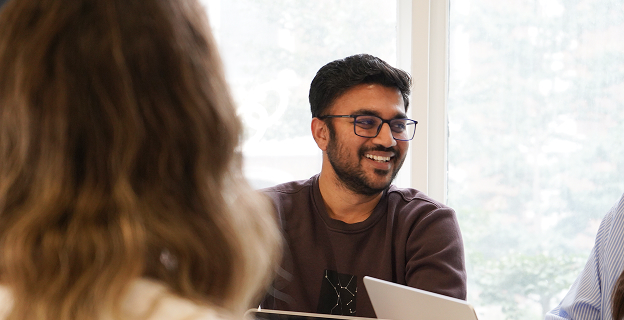Making the best possible choice of content management system (CMS) is crucial for the success of your website. But, these days, not only do you have to navigate the many different options – from WordPress to Sitecore to Webflow – you also have the added challenge of deciding whether to go “headless” or not.
Whether to take the less conventional headless approach with your CMS is a decision that could cause some confusion. It could even cause some challenges with your website if you end up making the wrong choice.
In this article, we’ll help you understand exactly what a headless CMS is, when you may need to take that approach, and highlight some key considerations to make before finalising your choice.
What is a Headless CMS?
With a traditional CMS, the back-end and the front-end of the system are directly linked. This is how you use your CMS for both the content management (back-end) and to control how the content is presented to your website visitors (front-end).
In this context, the back-end of the CMS is sometimes referred to as the “body” and the “head” is the front-end. In a headless CMS, that front-end is decoupled from the back-end of the system, hence the term headless. With this approach, you use the back-end as normal for content management and the presentation of content in the front-end is handled completely separately.
This is valuable because it allows you to design your website front-end however you like, without any restrictions. However, it also requires more technical work from your development agency as a trade-off.
With a headless CMS, your content is presented to your audience on your live website by using APIs that take it from the back-end of the CMS. This use of APIs also allows you to publish the same content in a variety of different formats via different channels as well, but more on that later.
Scenarios in Which You Might Need a Headless CMS
It’s important to understand that you should only take a headless approach if it’s the most suitable way to meet a specific set of requirements or objectives.
Some scenarios in which you might need to take a closer look at adopting a headless CMS include:
If a large volume of content is a key component of your marketing strategy.
If you’re going to be producing and publishing a lot of content on your website, you may benefit from a headless CMS. Many people find it easier and more intuitive managing websites in the back-end of a headless CMS.
The decoupling of the front-end also means that your development agency will be the ones responsible for ensuring your audience is presented with dynamic, engaging content.
If you expect to have high volumes of traffic and need to maintain performance.
If the size of your website’s audience will put a heavy demand on your CMS’s performance, a headless system could be a worthwhile investment. Using APIs, and leveraging other intelligent techniques, the headless approach often delivers faster loading times, reduces the workload on your servers, and offers greater scalability.
If you have a multi-channel marketing strategy, or need to publish content across multiple digital touch-points.
The headless approach allows you to take one piece of content, upload it into the back-end, and seamlessly publish it across several channels, including website, mobile app, social media, email, and even internet-of-things (IoT) devices.
This can help you maximise consistency, while providing your users in each channel an experience optimised for their preferred context.
If you’re prioritising personalisation.
As personalisation is becoming much more important in modern marketing, headless CMSs are becoming more popular in enabling those tactics.
If you need to create personalised experiences for your website visitors based on their demographic data, past behaviour, preferences, and so on, a headless CMS may be the right option. This is a useful approach for delivering tailored content to individual visitors, improving your engagement and increasing conversions.
If you have a multi-lingual or multi-regional website.
Delivering the same content to visitors in different languages, across different locations, can also be made easier by using a headless CMS. Your localisation process can be streamlined by managing the content for all users just once in the back-end, then delivering it seamlessly in its different forms based on location or other conditions.
Key Considerations and Potential Pitfalls
While a headless CMS can be a great choice to deliver on the requirements discussed here, it’s still not a straightforward decision in these scenarios.
Firstly, it’s important to note that a traditional CMS like WordPress can still help you achieve all the things listed above, especially with the support of an experienced, talented agency. Secondly, there are some downsides to the headless approach that need to be considered while you’re evaluating your options.
Security
Security is an issue that needs careful consideration when looking into the headless approach. The headless architecture, and use of APIs, create more security vulnerabilities than you’d have with a traditional CMS.
It’s also common for a headless CMS to require more hands-on management in key areas such as hosting and compliance, as well as more thorough and frequent testing.
Development Complexity
When you ask your development agency to build, manage, and maintain your website using a headless CMS, you’re asking them for more complex work than they’d be facing with a traditional system. This complexity is something you need to be aware of, both in your selection of an agency capable of delivering your requirements, and in the additional workload you’re asking them to complete for you.
Time-to-Market
Following on from the previous point, more complex development work often results in a longer time-to-market for your website.
Developing a website using a headless CMS may require more time and resources from your agency to deliver the work for you. If you need to get your site up and running quickly, or if you may require future development work to be delivered quickly, a regular CMS may be a safer bet.
Technical Skills
Publishing content with a headless CMS may be easy, but if something goes wrong, or you need something changed, you’re unlikely to be able to do it yourself. A headless CMS requires more technical skills and development experience to maintain than a traditional CMS, even for small tasks. If you don’t have these skills in your team, you’ll be more reliant on your agency partner than you would be with a normal CMS.
Total Cost of Ownership
All the points listed here will add up to a higher total cost of ownership (TCO). When accounting for the higher volume and greater complexity of work you’ll require from your agency, you’re likely to spend a lot more of your budget on a headless CMS.
Unless you have specific complex requirements that demand the use of a headless CMS, it’s usually the more cost-efficient option to go with the more traditional approach.
Content Strategy
With all that said, it’s also important to consider whether a headless CMS is even necessary based on your content strategy.
Unless you have an intricate, wide-ranging content strategy that spans various channels and platforms, it might not be worth adopting a headless CMS at all.
Most of the requirements you have can likely be delivered by working with a reliable agency partner using a sophisticated, flexible CMS like WordPress.
It’s also important to note that WordPress can be used in a headless context as well. This offers you a balance between a familiar, easy-to-use system and a more dynamic UX for your visitors in the front-end.
The Benefits of a Headless CMS
If you do decide to take a headless approach, your CMS can deliver a wealth of benefits and strategic advantages. These include:
Scalability
The headless architecture will enable you to build out your digital presence rapidly, on a large scale, across multiple channels. This scalability will be crucial for your website as your business grows and your requirements evolve.
Customisation
Both the back-end of your headless CMS and the front-end presentation of your content are entirely customisable, tailored to your specific requirements.
Flexibility
Headless CMSs provide a great deal of flexibility in terms of your selection of technology, content creation, and implementation of a multi-channel market strategy.
Ease-of-Use
If you work with a skilled agency partner who can set up and manage your system for you, publishing and editing content with a headless CMS becomes quick, easy, and efficient.
User Experience
Delivering your content seamlessly – and consistently – across a wide range of channels and digital touch-points creates a far greater UX for your target audience.
Performance
The headless architecture removes the need to render pages on your server. This creates the faster loading times and improved performance discussed previously, which also contributes to a better experience for your visitors.
Competitive Differentiation
As mentioned earlier, the headless approach allows you to create a truly unique UX. In an increasingly crowded, noisy online landscape, this can help you differentiate your website and stand above your competitors.
Future-Proofing
A headless CMS allows you to easily change or upgrade the technology you use for your front-end without having any impact on your back-end. This will help you become more agile and adapt quickly as new technology trends emerge in future.
Making the Right Decision for Your Unique Requirements
Ultimately, you should base your decision here on the specific requirements you have for your website and the circumstances you find yourself in.
While a headless CMS does offer a range of innovative capabilities, the additional costs and resources you’ll need to invest may not be worthwhile. For example, the traditional use of WordPress can provide you with most of the benefits discussed earlier.
Carefully consider your objectives, your strategy, and the resources you have available. Use those to weigh up all the pros and cons listed in this article in relation to your own website project.
The key thing is to clearly understand exactly what you need from your CMS, and use that to select the option that aligns best with your requirements.






